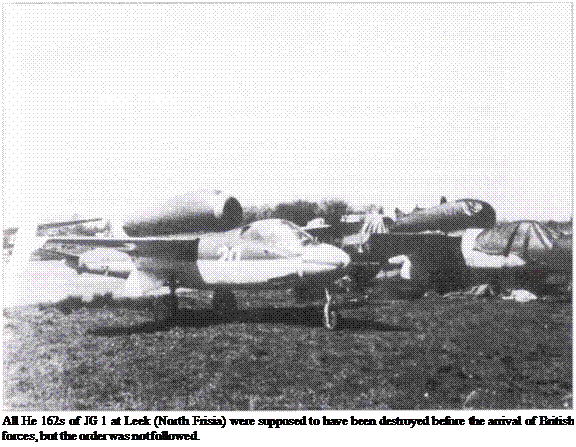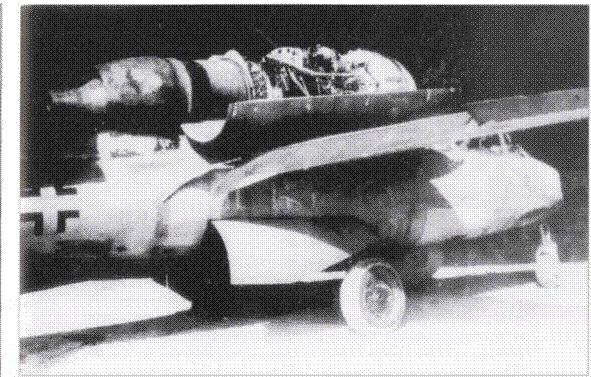Operations on the Back-burner
Because of the constant delays, JG 1 had not become active again until mid – March after its earlier problems. The Auffangsstaffel was subsequently reformed as Stabstaffel/JG 1: at the same time I./JG 1 transferred to Ludwigslust and II./JG 1 to Garz, countermanding a previous order to fly to Warnemiinde. Not until 8 April did the first two machines reach I. Gruppe from the central
German production. By 11 April conversion training was being carried out with up to 16 He 162s, but the fuel shortage kept training flights down to 10 or 12 per day. Even so, 30-40 pilots had had their first flying experience with the jet. During this training the Gruppe lost several pilots, amongst them Ober – feldwebel Stenschke and two Unteroffizier, Enderle and Werner. Despite all its protests, II./JG 1 had no He 162s; its conversion training got under way finally on 20 April.
 |
On 14 April I./JG 1 led by Oberleutnant Demuth, transferred from Ludwigslust to Leek with a refuelling stop at Husum because the Gruppe did not have enough fuel for a non-stop flight. During this flight, Leutnant Rudolf Schmidt encountered a Spitfire which was shot down, but the victory was credited to a flak battery which also fired on the RAF aircraft. During the continuation flight to Leek, Allied fighters appeared, but the ten-strong formation escaped at high speed. On 18 April the greater part of the ground staff arrived at Leek from Warnemiinde.
Despite the numerous improvements the Volksjager was still not completely safe in all flight situations. On 20 April Leutnant Schmitt needed the ejector seat to save himself and three days later Unteroffizier Steeb of L/fG 1 was forced to jump out after his ejector seat failed to work. On 24 April the commander of II./JG 1, Hauptmann Dahne, killed himself by operating the ejector seat without having first opened the cabin hood. Other fatalities in flying accidents with the He 162 between 20 and 26 April were Fahnrich Halmel and two Unteroffiziere, Fendler and Rechenbach. All were buried in Leek cemetery. The number of operational machines was few because of fuel shortage. Hauptmann Ludewig and his wingman, Feldwebel Gehrlein, were forced to make emergency landings for lack of fuel.
During the last weeks of the war the main focus of fighter operations over northern Germany was against RAF low-level aircraft. This included operational units of JG 1. From 25 April some He 162s were therefore used in this role over the Flensburg-Heide-Schleswig area. A pair from I. Gruppe attempted unsuccessfully to intercept an RAF Mosquito. There were no successes reported the following day, although Leutnant Gerhard Hanf attacked an RAF Typhoon. By 29 April Hanf had flown a further six sorties with his Volksjager. On 27 April the remainder of II./JG 1 arrived at Leek from Mecklenburg after refuelling at Kaltenkirchen. The number of training and operational flights in the next few days fell off for the lack of new aircraft and shortage of fuel. On 2 May the Kommodore, Oberstleutnant Herbert Ihlefeld, arrived at Leek with the Geschwaderstab.
On 4 May OKL merged I. and II. Gruppen under the Kommodore of I.(EG)/fG l. The first and second operational Staffeln led by Major Zober and Hauptmann Ludewig were then merged into the new Gruppe. All who had sufficient experience with the He 162 to engage low fliers over northern Germany were now assembled in this Gruppe.
Despite the war situation flights continued when fuel allowed, between one and three operations for two to four machines daily. These resulted in a few flying accidents shortly before the war’s end. Feldwebel Oskar Kohler ran out of landing strip at Leek and folded his He 162 A-2, being pulled free from the wreck by Oberleutnant Demuth at the last moment. Leutnant Schmitt flew some of the last operations. According to his flight log, his fifth patrol was on 4 May in ‘White Ґ when he caught up with an RAF Typhoon and scored hits. The aircraft crashed, but was credited to a flak unit on the basis of the captured RAF flier s report. The latter spent the last few days of the war in the JG 1 mess waiting for the Allies to arrive.
Shortly before the war’s end it was decided to send the operational Gruppe to northern Denmark or southern Norway, which proved impossible for lack of fuel, and on 5 May the aircraft were rigged with explosives to prevent their
 |
capture. Towards midnight the Kommodore ordered the charges removed and a few hours later the Germans surrendered to a British armoured car which arrived at the airfield. One of the British guards was killed shortly afterwards while fooling with the ejector seat of an He 162. The remnants of JG 1 remained at Leek until 15 May. On the 21st they arrived at Schorholm and were then given quarters at Hennstadt. A period in PoW camps terminated within a year in repatriation.
JG 400 was never equipped with the machine.
According to QM-General (6. Division) statistics, 116 completed He 162 aircraft were produced. The delivery of 60 of these can be proven. In total about 180 He 162s were ready for delivery. Fuselages, wings and tailplanes were in preparation for another 500. The majority of the serviceable machines in May 1945 were on the airfield at Leek. Of the 31 machines there, about 20 were airworthy to some extent. Of these, 5 went to the USA and France and 12 to Britain. Ten unserviceable machines were scrapped. Trials of the light fighter continued in France until 1948, and longer in the United States. It was accepted that the concept was well in advance of contemporary Allied standards.










